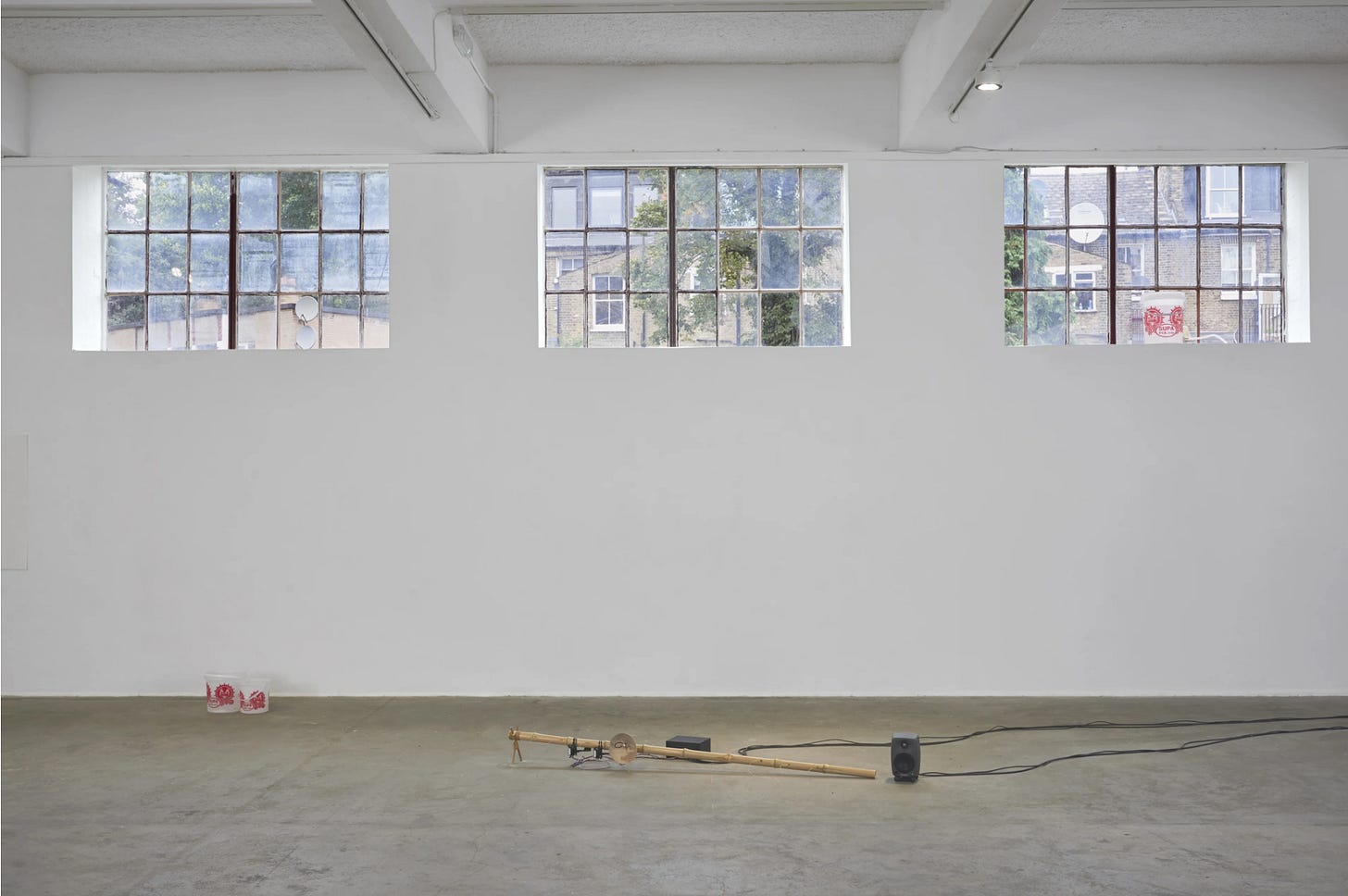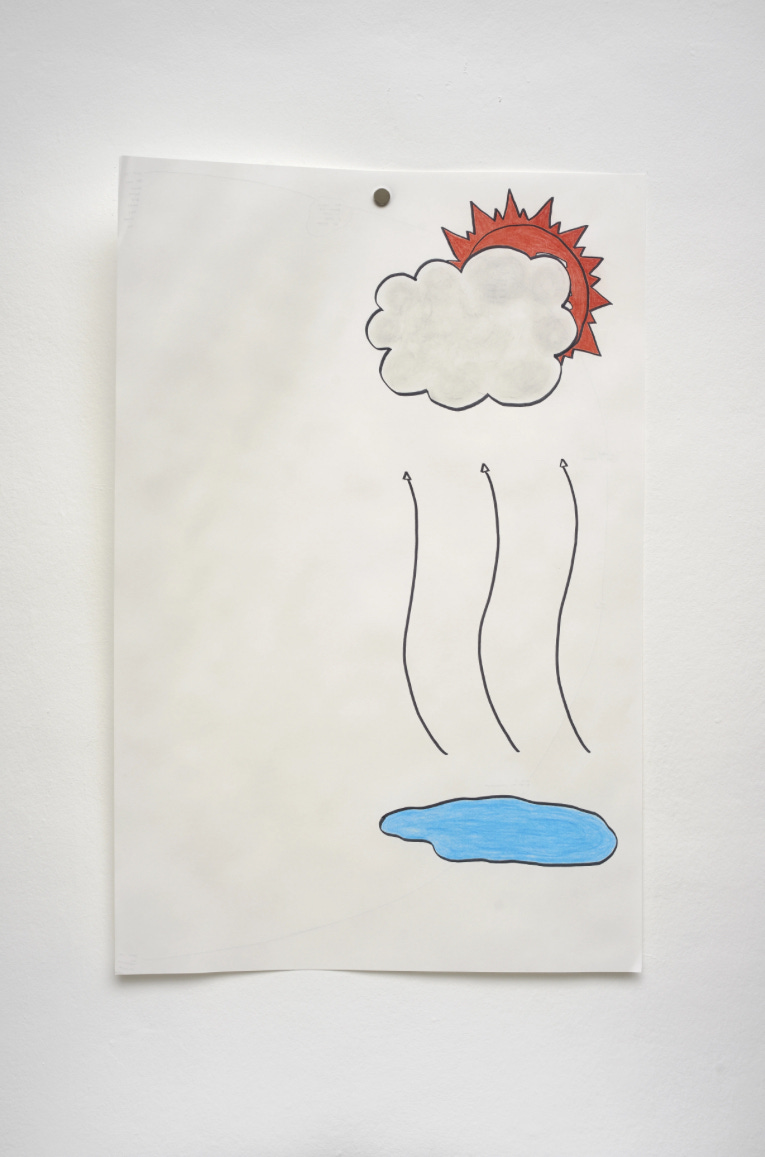hygrosummons (iter.01)
Simnikiwe Buhlungu at Chisenhale
There is has been a stark transformation in the gallery since I have last been to Chisenhale. True, that was over a year ago, but the space has been radically remodelled, so that I am confused as to where the room I had seen on my last trip has gone. Most noticeably, the gallery is light and airy, and the walls and ceiling are whitewashed as further sun streams in. I am reminded of how, during Ayo Akingbade’s Show Me The World Mister (2022), the windows in the gallery space were obscured partially to cast a subdued light on the space. Now, this paneling is bright and allows the natural rays of outside light into the space.
Siminkiwe Buhlungu, hygrosummons (iter.01), 2024, Installation view, Chisenhale Gallery, photo: Andy Keate.
The current exhibition, hygrosummons (iter.01) by Simnikiwe Buhlungu, circulates in continuation around function and environment. Just as the gallery has found new function, many of the pieces within it now have multiple lives and layered pasts. The doors to the gallery have been swelled and bloated since their first usage as homes for birds on the Hertford Union Canal. Now they frame the entrance to the gallery space with their watery past. This is fitting, as hygrosummons (iter.01) is a complex system of different climates, territories, and behaviours framed by water in its different forms. Buhlungu plays particularly with the variety of ways to showcase the medium, relying on Chisenhale’s environment to provide its own settings that will regulate the levels of water found in a bucket or in the humid air at any given time. In an interview with curators Olivia Aherne and Amy Jones, Buhlungu describes: “ In the show, we don’t have an orator, but rather rely on the response of the other elements in the gallery- paper curling, a vibrating bucket, and warped wooden doors whose changing material forms will attempt to be in a sonically outputted call and response with the composition.”
Buhlungu refers here to the composition of the two zithers that are arranged on the floor of the gallery, echoing to one another with clicking and tapping sounds. The artist explains how these instruments, inspired by traditional Mvets and crossed with an experimental hair hygrometer using finely braided Raffia, adjust to the humidity in the space, and play in response to this. In addition, the instruments are programmed to be played by robotic pluckers in a thirty minute sequence, meaning there is no person who “orates” the sequence. It appears that the main variables here truly are time and water.
This cycle of events dictated by fluctuating humidity is interweaved with the sources of water found at the gallery. Buhlungu uses samples to record the interaction between different geographical spaces, considering how our societal movements mimic the changes in climate and the cumulus in the clouds. The Tswaing Crater in Soshanguve, the backyard maize garden of Buhlungu’s mother, the Salse di Nirano Nature Reserve in Fiorano Modenese, and puddles outside of Chisenhale Gallery, all interact with another as they move through the gallery space, from bucket, to zither strings, to air vent. These flexible, ambiguous lives find a common denominator in the container Buhlungu has chosen for her water buckets. Several Supa PVA buckets are dotted around the space, originally used to store a water- based paint popular in rural areas of South Africa. Buhlungu describes her choice in the vessel: “For me it’s about that accessibility… They’re not just one thing. They have multiple lives and uses.” Ironically, the artist then explains that Supa PVA, so ubiquitous in one region of the cape, becomes particularly elusive internationally. This reminder of regional comforts and the distance each bucket has traveled to provide its purpose to the gallery is not lost on me.
Siminkiwe Buhlungu, Exit and Cycles, 2024, Chisenhale Gallery, photo: Andy Keate
In hygrosummons (iter. 01), there is no narrator, or set story. Rather, the climate of the space and its additional samples from different countries interact to form a new ecology that functions differently per each visit to the space. A rainy day pulls away a new corner of Exit and Cycles, 2024, from the wall, revealing a new shower of thoughts written underneath. I wonder if I visit again, what the instruments will play, and what words the walls will show me. This sense of continued not-knowing, a lingering between the geography of the space and the messages revealed, informs a continuous cycle of unpredictable conversation formed of seen and unseen variables.
Pictures courtesy of Chisenhale Gallery.




